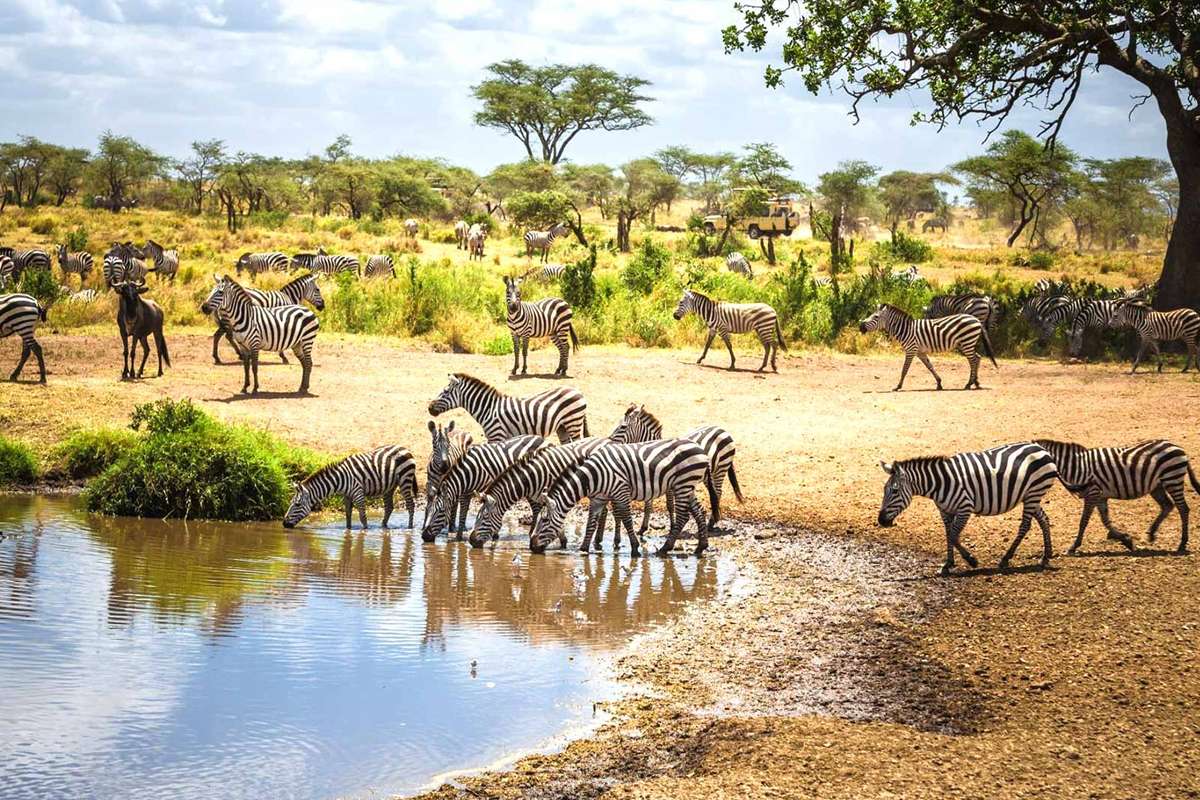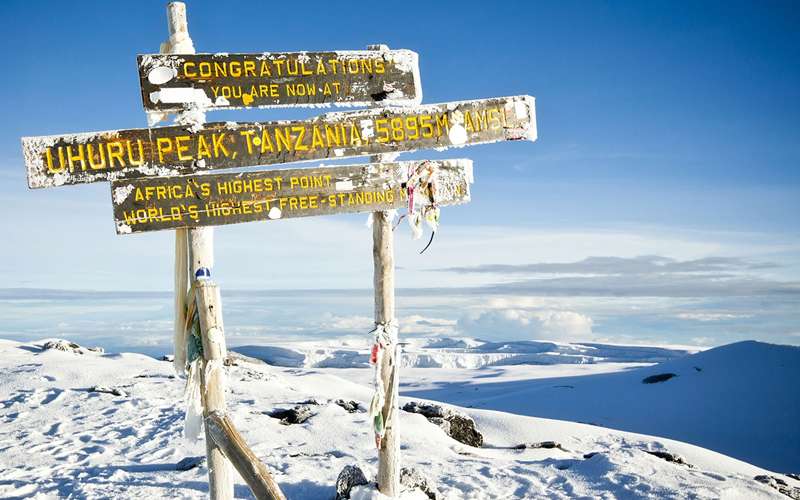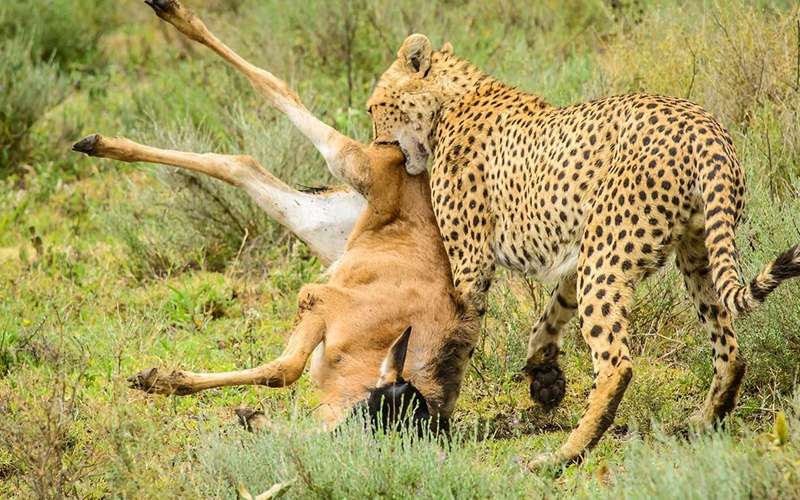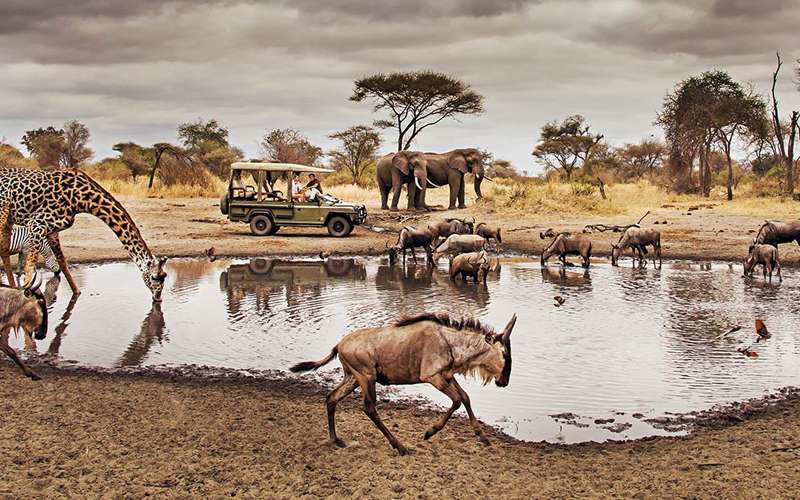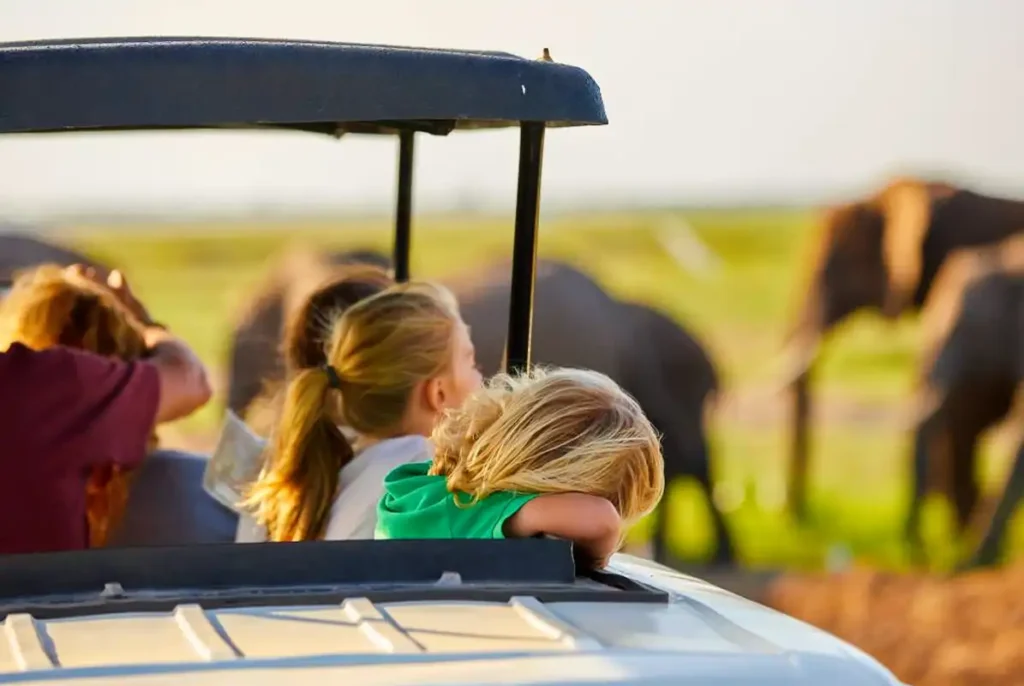Tanzania is a land of unparalleled beauty, home to some of the world’s most breathtaking natural wonders and a vibrant array of wildlife. It’s no surprise that this East African gem holds some of the most impressive records in safari tourism. Whether you’re an avid wildlife enthusiast, a curious traveler, or someone who loves records, Tanzania’s safaris promise experiences that are truly unforgettable.
Tanzania’s Big Five: Setting the Record Straight
When people think of African safaris, the “Big Five” often come to mind. In Tanzania, spotting all five is not just a possibility; it’s almost guaranteed. The Big Five includes the lion, leopard, rhinoceros, elephant, and Cape buffalo. Here’s a closer look at the recorded sightings of these majestic animals in Tanzania:
- Lions: The Kings of the Serengeti: The Serengeti is renowned for its dense population of lions, holding one of the highest concentrations of these big cats in the world. Record sightings of pride sizes have been reported, with some pride numbering up to 30 individuals.
- Leopards: The Elusive Hunters: Leopards are notoriously difficult to spot, but Tanzania’s Ruaha National Park holds records for frequent sightings, especially near the Great Ruaha River, where these solitary hunters are often seen lounging in trees.
- Rhinoceros: The Conservation Success: Tanzania has made remarkable strides in rhino conservation. The Ngorongoro Crater is one of the few places where you can still spot the critically endangered black rhino, with record sightings being celebrated as a conservation triumph.
- Elephants: Giants of Tarangire: Tarangire National Park is known for its large elephant population, with records showing some of the highest densities of elephants in East Africa. These giants roam the park in large herds, particularly during the dry season.
- Cape Buffalo: The Resilient Grazers: Cape buffaloes are a common sight in Tanzania’s parks, particularly in the Serengeti and Ngorongoro Crater. They are known for their resilience and can be seen in large herds, setting records for their numbers.
The Serengeti Migration: A Phenomenon in Record Books
One of the most extraordinary events on the planet, the Great Wildebeest Migration, occurs annually in Tanzania’s Serengeti National Park. This migration is often described as the “Greatest Show on Earth,” with over 1.5 million wildebeest, 200,000 zebras, and numerous gazelles making their way across the plains in search of greener pastures.
- Record Numbers and Unbelievable Facts: The sheer number of animals involved in this migration is staggering. Records indicate that up to 1.7 million wildebeest take part in this journey, making it the largest terrestrial mammal migration in the world. The crossing of the Mara River, where crocodiles await, is one of the most anticipated events, drawing wildlife enthusiasts from across the globe.
- When and Where to Witness the Migration: The best time to witness the Great Migration is between June and October, as the herds cross the Mara River into Kenya’s Maasai Mara before returning to the Serengeti. The Ndutu region in the southern Serengeti is also a prime spot to witness calving season between January and March, another record-setting event.
- Ngorongoro Crater: Record-Breaking Biodiversity: The Ngorongoro Crater is a natural wonder and a UNESCO World Heritage site. This vast volcanic caldera is often referred to as “Africa’s Eden” and holds records for its incredible biodiversity.
- The Crater’s Unique Ecosystem: The Crater’s floor is home to around 25,000 large animals, including elephants, lions, and hippos, making it one of the densest concentrations of wildlife in the world. The diversity here is unparalleled, with a mix of forests, swamps, and grasslands providing a haven for a variety of species.
- Unmatched Density of Predators: Ngorongoro Crater holds the record for the highest density of predators in Africa. This includes a healthy lion population, as well as numerous hyenas and cheetahs. The crater is also one of the few places where you can see the rare black rhino in its natural habitat.
- Historical Records and Conservation Successes: The Ngorongoro Crater is not just a place of natural beauty; it’s also a conservation success story. The reintroduction of black rhinos into the Crater and the thriving lion population are testaments to Tanzania’s commitment to preserving its wildlife heritage.
Mount Kilimanjaro: Safari from the Summit
Mount Kilimanjaro, Africa’s highest peak, is not only a challenge for mountaineers but also a unique safari destination.
- The Record-Setting Climbs: Kilimanjaro holds the record for being the tallest free-standing mountain in the world, with climbers from all over the globe attempting to reach its summit. Some records include the fastest ascent and the youngest and oldest climbers to reach the top.
- Kilimanjaro’s Role in Safari Experiences: The lower slopes of Kilimanjaro are home to a rich array of wildlife, including elephants, leopards, and buffaloes. This makes a climb up the mountain a unique safari experience, combining both adventure and wildlife observation.
- Flora and Fauna on Kilimanjaro: The mountain’s varied ecosystems, from lush forests to alpine deserts, are home to unique plant and animal species, some of which are endemic to Kilimanjaro, setting records for biodiversity.
Tarangire National Park: The Elephant Paradise
Tarangire National Park is often overshadowed by its more famous neighbors, but it holds some impressive records, particularly when it comes to its elephant population.
- Elephant Population Records: During the dry season, Tarangire hosts the largest concentration of elephants in Tanzania. Herds of up to 300 elephants can be seen migrating through the park, making it one of the best places in the world to observe these magnificent creatures in their natural habitat.
- Unique Wildlife and Birdlife: Tarangire is also home to an extraordinary variety of bird species, with records indicating over 550 species. This makes it a paradise for birdwatchers, who flock to the park to witness the avian diversity.
- Best Time to Visit Tarangire: The best time to visit Tarangire is during the dry season, from June to October, when the wildlife congregates around the Tarangire River, providing spectacular viewing opportunities.
Lake Manyara National Park: The Birdwatcher’s Dream
Lake Manyara National Park is another gem in Tanzania’s safari crown, particularly known for its birdlife.
- Record Bird Species Count: Lake Manyara is home to over 400 species of birds, with some records indicating sightings of over 300 species in a single day. This is a record that few places on Earth can match.
- The Famous Tree-Climbing Lions: In addition to its birdlife, Lake Manyara is famous for its tree-climbing lions, a rare behavior observed in only a few places around the world. This unique characteristic has put Lake Manyara on the map as a must-visit destination for safari enthusiasts.
- Conservation Efforts and Achievements: Lake Manyara has also seen significant conservation successes, particularly in protecting its large elephant population and the fragile ecosystem of the lake itself, which supports a variety of aquatic species.
Records in Conservation: Tanzania’s Efforts
Tanzania is not just a place for viewing wildlife; it’s also at the forefront of conservation efforts in Africa.
- National Conservation Initiatives: Tanzania has implemented several national initiatives to protect its wildlife, including anti-poaching campaigns and habitat restoration projects. These efforts have led to record recoveries of certain species, such as the black rhino and African wild dog.
- Record Success Stories: One of the most notable success stories is the increase in elephant populations in Tarangire and other parks, thanks to stringent anti-poaching measures. Similarly, the Serengeti has seen a resurgence in cheetah numbers, setting records for predator recovery.
- The Role of Local Communities: Local communities play a crucial role in conservation efforts. Community-based conservation programs have helped reduce human-wildlife conflicts and have led to record levels of local engagement in wildlife protection.
Safari Lodges: Luxury and Sustainability Records
Tanzania’s safari lodges are not just places to stay; they are record-holders in luxury and sustainability.
- Record-Holding Luxury Lodges: Some of Tanzania’s lodges, such as Singita Grumeti and Ngorongoro Crater Lodge, are regularly listed among the best in the world. These lodges offer unparalleled luxury while maintaining a strong commitment to sustainability.
- Sustainable Safari Tourism: Many lodges in Tanzania are pioneers in sustainable tourism, setting records for eco-friendly practices. From solar power to water recycling, these lodges are at the forefront of reducing their environmental footprint while providing a world-class safari experience.
- Awards and Recognition: Tanzania’s lodges have received numerous awards for their contributions to sustainable tourism, including recognition from organizations like the World Travel Awards and the Global Sustainable Tourism Council.
Tanzania’s Safari Economy: A Record-Breaking Industry
The safari industry is a vital part of Tanzania’s economy, contributing significantly to the nation’s GDP.
- Economic Impact of Safari Tourism: Safari tourism generates billions of dollars annually for Tanzania, making it one of the top contributors to the country’s economy. Record-breaking visitor numbers have been reported in recent years, with millions of tourists flocking to Tanzania to experience its natural wonders.
- Record-breaking revenue and Visitor Numbers: Tanzania has set records for the number of international visitors, with a significant increase in tourists from Europe, North America, and Asia. This surge in tourism has led to record revenues, which are reinvested in conservation and community development projects.
- Future Projections and Potential Growth: The future of Tanzania’s safari industry looks promising, with projections indicating continued growth. The government’s focus on sustainable tourism and the development of new parks and reserves is expected to set new records in the coming years.
Historic Safaris: Pioneering Records
Tanzania has a rich history of pioneering safaris, with records dating back to the early 20th century.
- Early Explorers and Their Impact: Early explorers like Frederick Selous and Richard Francis Burton set records for their expeditions through Tanzania, mapping uncharted territories and documenting the region’s rich biodiversity. Their work laid the foundation for modern safari tourism.
- Records Set by Safari Pioneers: Pioneers like John Boyes, who was known as the “King of the Wa-Kikuyu,” set records for their adventures in East Africa. Their stories continue to inspire safari enthusiasts today, highlighting Tanzania’s long-standing reputation as a premier safari destination.
- The Evolution of Safari Experiences: The safari experience in Tanzania has evolved significantly over the years, from the early days of hunting expeditions to today’s conservation-focused safaris. This evolution has led to the establishment of record-breaking parks and reserves that are recognized globally.
Tanzania’s Unique Safari Experiences
Tanzania offers a variety of unique safari experiences that set it apart from other destinations.
- Hot Air Balloon Safaris: A Record-Setting Adventure: One of the most unforgettable ways to experience Tanzania’s landscapes is from the air. Hot air balloon safaris over the Serengeti offer a bird’s-eye view of the migration and other wildlife, setting records for unforgettable experiences.
- Walking Safaris: Breaking the Norm: Walking safaris in Tanzania offers a more intimate way to explore the bush. Records show that these safaris are gaining popularity, allowing visitors to get up close and personal with wildlife in a way that traditional vehicle safaris cannot match.
- Cultural Safaris: Records of Human-Wildlife Interaction: Cultural safaris provide insight into the lives of Tanzania’s indigenous communities, such as the Maasai and Hadzabe. These experiences set records for the depth of cultural immersion and the unique opportunity to learn about traditional ways of life.
Wildlife Photography: Capturing Record Moments
Tanzania is a paradise for wildlife photographers, offering opportunities to capture record-breaking moments.
- Iconic Photos Taken in Tanzania: Some of the most iconic wildlife photos ever taken have been captured in Tanzania. These images have won international awards and set records in wildlife photography competitions.
- Records in Wildlife Photography Competitions: Tanzania’s national parks have been the backdrop for numerous award-winning photographs, with the Serengeti and Ngorongoro Crater being particularly popular among photographers looking to capture the perfect shot.
- Tips for Capturing Record-Worthy Photos: To capture the best wildlife photos in Tanzania, it’s essential to have the right equipment and to be patient. Early morning and late afternoon are the best times for photography, as the light is softer, and the animals are more active.
Challenges and Future Records in Tanzania’s Safaris
While Tanzania holds many records in safari tourism, there are challenges that need to be addressed to ensure future success.
- Environmental Challenges and Their Impact: Climate change and habitat loss pose significant challenges to Tanzania’s wildlife. These issues threaten to impact Tanzania’s records, particularly in terms of biodiversity and species populations.
- Potential Records to Be Set in the Future: Despite these challenges, there are opportunities for new records to be set. The development of new protected areas and continued investment in conservation could lead to new records in wildlife populations and biodiversity.
- Innovations in Safari Tourism: Innovations in technology and sustainable tourism practices are likely to shape the future of Tanzania’s safari industry. These innovations could lead to new records being set in visitor numbers, conservation successes, and unique safari experiences.
Tanzania is a land of records, from its incredible wildlife to its pioneering conservation efforts. Whether you’re interested in seeing the Big Five, witnessing the Great Migration, or experiencing a hot air balloon safari, Tanzania offers something for everyone. As Tanzania continues to break records in safari tourism, now is the perfect time to experience these wonders firsthand.
FAQs
What is the best time of year to witness the Great Migration in Tanzania?
The best time to witness the Great Migration is between June and October when the herds cross the Mara River. The calving season from January to March is also an excellent time to visit.
How does Tanzania’s wildlife conservation compare to other African countries?
Tanzania is a leader in wildlife conservation, with successful initiatives that have led to the recovery of endangered species and the protection of vast wilderness areas.
What are Tanzania’s most famous safari records?
Tanzania holds records for the largest terrestrial migration (the Great Wildebeest Migration), the highest density of predators (Ngorongoro Crater), and the largest concentration of elephants (Tarangire National Park).
How can I capture the best wildlife photos on a Tanzanian safari?
To capture the best photos, use a camera with a good zoom lens, and try to shoot during the early morning or late afternoon when the light is soft and the animals are active.
What makes Tanzania’s safari lodges unique in terms of luxury and sustainability?
Tanzania’s safari lodges combine luxury with sustainability, often using eco-friendly practices such as solar power and water recycling. These lodges are also recognized globally for their contributions to sustainable tourism.
For an extraordinary Tanzanian experience, explore the following highlights on our site:
- Climbing the Roof of Africa
- Positive Impacts
- Tanzania Family Safari
- Tanzania Honeymoon Safari
- Tanzania Safari
- Tanzania Walking Safari
- Terms and Conditions
- Zanzibar Vacation
- Maasai Village Experience
- Contact Us
Visit our page for detailed information and tips to plan your perfect Tanzanian adventure.


